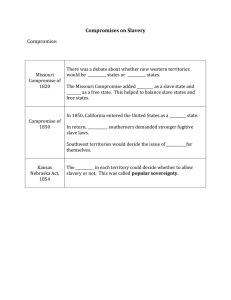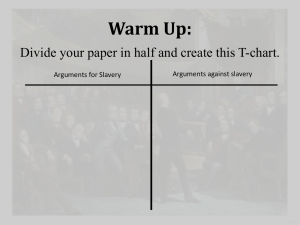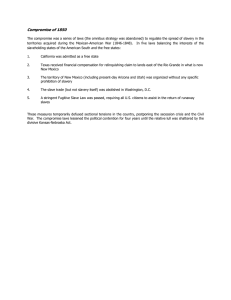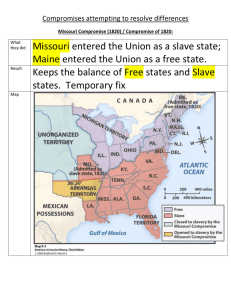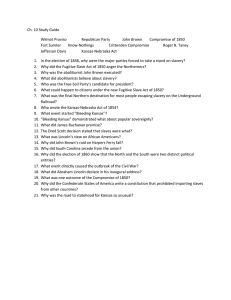Causes of the Civil War
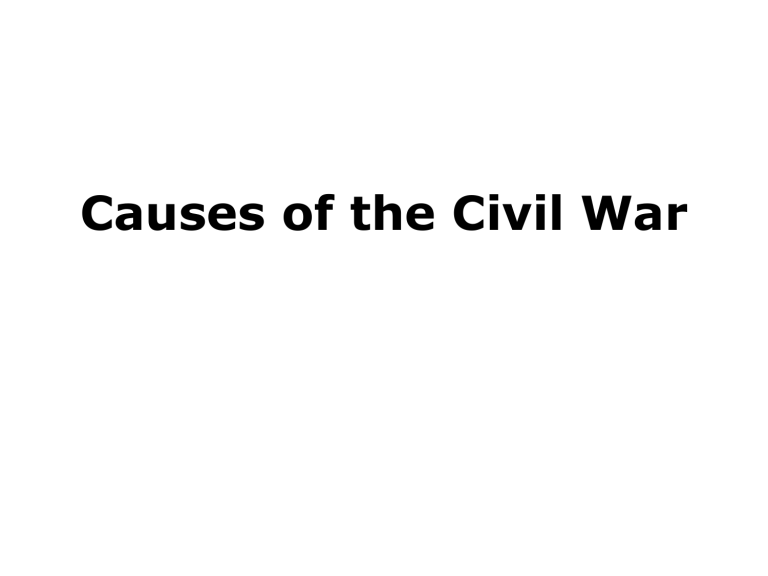
Causes of the Civil War
Tariff of 1816
• As part of the plan known as the American
System, President Madison proposed this tariff.
• The tariff increased the cost of foreignmade goods and thus make American goods more attractive.
• In the South this tariff was known as the
Tariff of Abominations
Missouri Compromise
• Legislative compromise reached in 1820 that preserved the balance of free states and slave states
• Admitted Missouri as a slave state and
Maine as a free state
• Banned
slavery
north of the line marked by extending Missouri’s southern border all the way west of the Pacific Ocean
• Maintained peace for almost 30 years, until the
Compromise of 1850
Nat Turner
• Slave
• Led the largest slave revolt in U.S. history in
Virginia in 1831
• Led a band of slaves who swept across the countryside, killing nearly 60 whites before they were captured and executed
• Was convinced that he was a messianic figure
Abolitionists
• Blanket term for those who supported the abolition of slavery
• Most famous leaders were Frederick
Douglas, William Lloyd Garrison, and
John Brown
• Held some power in Congress, but not enough to outlaw slavery until after the south seceded and the Civil War began
• Represented first by the Liberty party and later by the Free Soil party
William Lloyd
Garrison
• Most famous of all the abolitionist leaders
• Published an abolitionist newspaper called:
“The Liberator, famed for fiery rhetoric
• One of the ardent abolitionists who opposed the Free Soil party.
Liberty Party
• A moderate abolitionist political party that opposed the spread of slavery
• Fielded candidates in the presidential elections of 1840 and 1844
• Was subsumed by the more successful Free
Soil Party
Wilmot Proviso
• A legislative rider introduced in 1846 by David
Wilmot, a member of the House of Representatives from Pennsylvania
• Proposed banning the expansion of slavery into any land taken from Mexico in the Mexican-American
War
• Passed the
House of Representatives more than a dozen times, but was always defeated in the Senate
• Supporters of the
Wilmot Proviso became founders of the Free-Soil Party
• Was the issue that finally fractured the
Whig Party
Compromise of 1850
• Reached to prevent an imbalance of slave and free states after a perfect balance had been so carefully maintained, beginning with the Missouri Compromise and extended through the next 30 years
• Necessary when president Zachary Taylor suggested disrupting the balance by admitting both California and
New Mexico as free states (states where slavery would be illegal)
• Maintained peace by creating a package of six laws that admitted California as a free state, split the Mexican
Cession territory into two territories (New Mexico and
Utah), resolved a boundary dispute between Texas and the
New Mexico Territory, abolished the slave trade in the
District of Columbia, and passed the Fugitive Slave Act
• Postponed a sectional crisis between the north and the south for a few more years
• Led to the final split of the Whig Party
Fugitive Slave
Act
• Passed as part of the Compromise of 1850
• Guaranteed slave owners the right to capture escaped slaves anywhere in the U.S. and the right to claim escaped slaves who were captured by others
• Drew immense criticism from abolitionists in the north
• Gave rise to personal liberty laws designed to interfere with the execution of the Fugitive Slave law in many
Northern states
• Inspired Harriet Beecher Stowe’s famous novel Uncle
Tom’s Cabin
• Reviewed by the Supreme Court in the case of Dred Scott
V. Sandford
Popular Sovereignty
• An attempt to soothe tensions during the Sectional crisis that preceded the Civil War
• First made law in the
Compromise of 1850
• Brainchild of
Stephen Douglas
• Allowed the residents of a territory to decide themselves – by referendum or by the adoption of a state constitution – whether or not they wanted to allow slavery in their territory
• Led to the crisis of “Bleeding Kansas” when it was the basis for the Kansas-Nebraska Act
• Was a major topic in the
Lincoln-Douglas Debates
Republican Party
• Formed in the mid 1850’s by northern abolitionists distressed by the passage of the Kansas Nebraska Act and the incidents in “ bleeding
Kansas”
•
Abolitionists disappointed that both the Whig Party and the
Democratic Party had agreed to settle for popular sovereignty joined together in the new party
• Nominated Abraham Lincoln in the election of 1860
• Controlled American politics from the election of Abraham Lincoln in
1860 through the end of reconstruction in 1877
• One of two dominant parties in American politics today
• Other famous members included
Dwight D. Eisenhower and Ronald
Reagan
free
Free-Soil Party
• A Third Party that significantly affected American politics
• Gathered many proponents of abolitionism in the years before the Civil War
• Drew support from pervious supporters of both the Whig party and the Democratic party
• Opposed the extension of slavery into any territory taken from Mexico and into any territory already declared “free soil” by the Missouri Compromise.
• Grew out of those who supported the Wilmot Proviso
• Replaced the Liberty party
• Fielded candidates in the presidential elections of 1852 and
1856
Know-Nothing Party
• A small political party that advocated a nativist ideology of being anti-immigrant, anti- Catholic, and anti-Jewish
• Officially called the American party but earned its nickname because members, when asked about the party, answered only, “I know nothing”
• Party nominated former president Millard Fillmore for the presidency in 1856
• Died out in the late 1850’s
Frederick Douglass
• A former slave who documented his experiences in the famous book A Narrative of the Life of __________ _________
• Major organizer and speaker in the abolitionist movement
Underground
Railroad
• A secret network of abolitionists who helped blacks escape slavery in the south in the years before the
Civil War
• Most famous leader was former slave Harriet
Tubman
“Bleeding
Kansas”
• Nickname for the Kansas Territory after Congress decided in 1854 that the status of slaves in Kansas would be decided by popular sovereignty
• Widespread violence preceded the vote on slavery in
Kansas, earning the “bleeding” moniker
• The vote was plagued by fraud, as slave owners from neighboring Missouri poured into Kansas to vote
• John Brown, a radical abolitionist, led a group of men in a massacre of slave owners after the abolitionist town of Lawrence, Kansas was ransacked
Dred Scott v. Stanford
• 1857 Supreme Court decision on the Fugitive Slave Law
• ________ ________ was a slave who had been taken by his master into the Minnesota Territory, which was free territory according to the provisions of the Missouri Compromise
• ________ sued for freedom, arguing that residence on free soil made him a free man
• The Supreme Court, led by Chief Justice Roger Taney , disagreed
• Decision not only upheld the
Fugitive Slave Law , but held that since _____ ______was not a citizen, he had no standing to seek help from the judiciary branch of the government, and therefore he had no legal rights under the
Constitution
• Decision caused an uproar in the abolitionist movement and added momentum to the sectional strife that led to the
Civil War
Roger Taney
• Close friend of President
Andrew Jackson
• Helped Jackson shut down the
Second National
Bank
• In return, Jackson appointed him chief justice of the
Supreme Court when John Marshall died in 1835
• Wrote a number of important decisions, including
Dred Scott v. Sanford
John Brown
• A radical abolitionist leader
• Supported the use of violence for the end of abolition
• Led a small retaliatory massacre in
“Bleeding Kansas”
• Led a more famous 1859 raid on the arsenal in Harper’s Ferry (then still in
Virginia) with the intention of arming slaves for a revolt
• Was arrested, tried, and hanged
Abraham Lincoln
• Little known politician from Illinois who challenged Stephen Douglas for an
Illinois seat in the Senate in 1858
• Engaged with Douglas in the Lincoln-Douglas debates, which vaulted him to widespread fame in the north
• Presidential candidate of the Republican party in the 1860 election
• Elected president in 1860 and 1864
• Led the Union in the Civil War against the Confederate States of America
• Delivered the famous Gettysburg Address
• Nicknamed “The Great Liberator”
• Outlined a modest plan for Reconstruction, but was assassinated by Southern
Sympathizer John Wilkes Booth in 1865, before he could implement his plan for Reconstruction
• Succeeded By Andrew Johnson, who was entirely ineffectual
Stephen Douglass
• Senator from Illinois in the years preceding the Civil War
• National leader of the
Democratic Party
• One of the architects of the Compromise of 1850
• Creator of the idea of popular sovereignty and author of the 1854 Kansas-Nebraska Act that led to “ Bleeding
Kansas
”
• Squared off against Abraham Lincoln in a famous series of debates (known as the Lincoln-_______ debates ) during the 1858 race for a seat in the Senate
• He defeated Lincoln in the Senate race, but lost to him in the presidential election of 1860
Lincoln-Douglas debates
• A series of seven debates between Abraham Lincoln and Stephen Douglas during the 1858 race for one of
Illinois's seats in the Senate
• Lincoln forced Douglas to enunciate his position of slavery in the wake of “Bleeding Kansas” and Dred
Scott v. Sanford
• Lincoln’s performance in the debates – including his famous line “A house divided against itself cannot stand” – won him widespread fame in the North
• Douglas lost the debates but won the election
• Lincoln’s performance set him up for the Republican party’s presidential nomination for the election of
1860 (in which he ran against Douglas)
• Why did the northern states favor high protective tariffs?
• It hurt European countries but helped all of the United States.
• It made the American system a success because everyone wanted to buy
American products because they were cheaper.
• It provided protection for northern manufacturers from foreign competition.
• It provided protection for northern manufacturers from the southern industries.
• What was the economy of the southern states in the early 1800's?
• industrial economy with slave-based labor
• agricultural economy with immigrantbased labor
• plantation economy with immigrantbased labor
• agricultural economy with slave-based labor
• Southerners argued that individual states could _____ laws passed by
Congress and began to insist that states had entered the Union freely and could leave freely. What term means to a state's refusal to recognize an act of Congress that it considers unconstitutional?
• nullify
• veto
• appease
• contain
• What act drew an east-west line through the
Louisiana Purchase making slavery prohibited above 36?30'?
• Compromise of 1850
• Compromise of 1820
• Louisiana Compromise
• Missouri Compromise
• The Missouri Compromise allowed one state north of the
36?30' to be a slave state. Which state was that?
• Kansas
• Missouri
• Tennessee
• Nebraska
• In 1831, who led slave revolts in Virginia that fed southern fears about slave rebellions and led to harsh laws in the south against fugitive slaves?
• Harriet Tubman
• Harriet Beecher Stowe
• Daniel Shays
• Nat Turner
• At what New York location did the first women's rights convention meet?
• Seneca Falls
• New York City
• Buffalo
• Albany
• What act admitted California into the union as a free state while the new Southwestern territories acquired from Mexico would decide for themselves?
• Compromise of 1820
• Compromise of 1850
• Kansas-Nebraska Act
• Treaty of San Lorenzo
• What act required slaves who escaped to free states to be forcibly returned to their owners in the South?
• Fugitive Slave Act
• Slave Rebellion Act
• Missouri Compromise
• Compromise of 1855
• Which best-selling Civil War novel inflamed Northern abolitionist sentiment while frightening Southerners?
• The Underground Railroad
• Uncle Tom's Cabin
• John Brown's Raid
• The Slave Rebellion
• What law produced bloody fighting in Kansas as pro- and anti-slavery forces battled each other?
• Compromise of 1820
• Compromise of 1850
• Popular Sovereignty Act
• Kansas-Nebraska Act
• What act repealed the Missouri
Compromise?
• Compromise of 1820
• Compromise of 1850
• Popular Sovereignty Act
• Kansas-Nebraska Act
• What was Lincoln's stance on slavery in the new states in the west?
• for the spread of slavery to every state
• opposed to the spread of slavery
• liked popular sovereignty
• liked slavery in the south but did not want to see it spread to the Pacific
• How did Stephen Douglas feel about the spread of slavery in the west?
• for the spread of slavery to every state
• liked popular sovereignty
• opposed to the spread of slavery
• liked slavery in the south
• Who inspired the 1856 Supreme
Court decision that overturned efforts to limit the spread of slavery and outraged northerners?
• Dred Scott
• John Brown
• Frederick Douglas
• Nat Turner
• Who helped to expand the abolitionist movement in the north by publishing an antislavery newspaper titled The Liberator?
• Frederick Douglass
• William Lloyd Garrison
• Sojourner Truth
• John Brown
• Which is NOT a lady involved with the women's suffrage movement before and after the
Civil War?
• Abigail Adams
• Susan B. Anthony
• Sojourner Truth
• Elizabeth Cady Stanton
• Who wrote Uncle Tom's Cabin?
• William Lloyd Garrison
• Harriet Tubman
• Dred Scott
• Harriet Beecher Stowe
• What does Lincoln's 1858 warning,
"A house divided against itself cannot stand," mean?
• the government can not withstand the economic split
• the White House must be added on to
• the slavery issue can continue if everyone does what they believe in
• the nation could not continue half-free, half-slave; slavery issue must be resolved
• What state led the south in secession?
• North Carolina
• Virginia
• Georgia
• South Carolina
